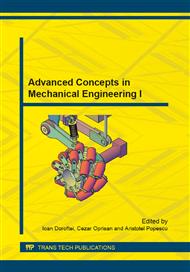p.429
p.435
p.441
p.447
p.453
p.459
p.465
p.471
p.477
New Design Concept for Reducing Torque Wear on Implant
Abstract:
The hip (coxofemoral) joint is built so as to provide, at the same time, maximum stability and mobility, and is characterized by a very low wear rate and very low frictional forces thanks to the very good natural lubrication. In time, due to various reasons such as aging, joint illnesses, bone tumors, arthritis, injuries, coxofemoral joints may lose their self-lubrication ability, causing pains that make movement almost impossible. The therapeutic solution for coxofemoral joint illnesses is hip implant arthroplasty. Medical implants replacing the bone segments of coxofemoral joints are subjected to mechanical stress during walking and daily activities, which leads to wear in the long run. In the (most frequent) case of a bipolar hip implant, consisting of a femoral stem and femoral head, the area most affected by wear is the hip implant coupling, which represents the connection between the sphere-shaped proximal end of the femoral stem and the femoral head’s ball groove. Typically, the spherical proximal end of the femoral stem is made of metallic biomaterials (titanium and titanium alloys, cobalt-based alloys, stainless steels) or ceramic biomaterials (alumina, zirconia), while the femoral head’s ball groove is made of polymeric biomaterials (high-density polyethylene), metallic biomaterials or ceramic biomaterials. In the hip implant’s coupling there takes place a sliding friction whose coefficient depends on the nature of the touching surfaces (metal on metal, metal on polyethylene, ceramic on polyethylene, ceramic on ceramic). The wear that occurs in the coupling is due especially to the particles of material detached from the surfaces coming into contact. A worn coupling should be replaced by a revision surgery that the patient must go through, since loose particles generate severe joint inflammation. The objective of this paper is: -to point out the wear degree of the components forming the friction coupling of a hip implant, by presenting images, as seen on a video microscope, of two implants retrieved from patients after revision surgery -to present a new structural option for the construction of a hip implant coupling, by introducing two ball cages that replace the femoral head’s ball groove, which reduces the contact surface and replaces sliding friction with rolling friction (with a lower friction coefficient), thus diminishing the wear on the implant coupling.
Info:
Periodical:
Pages:
453-458
Citation:
Online since:
October 2014
Authors:
Keywords:
Price:
Сopyright:
© 2014 Trans Tech Publications Ltd. All Rights Reserved
Share:
Citation:


